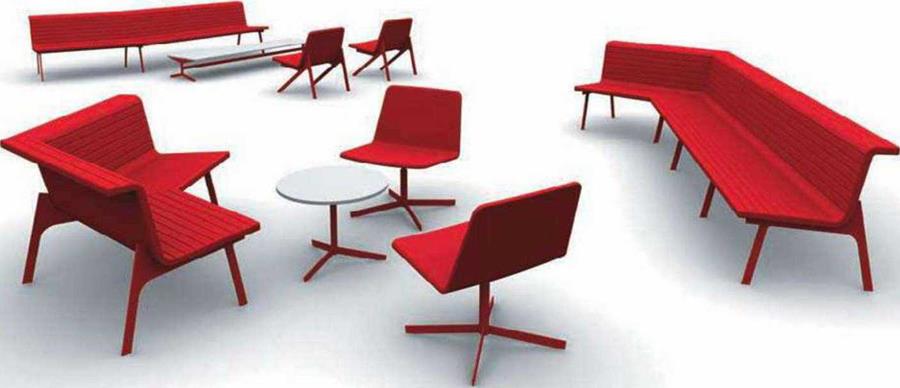
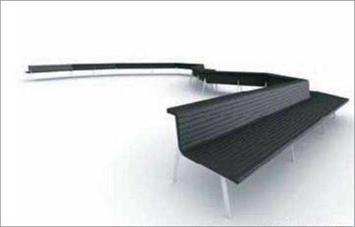
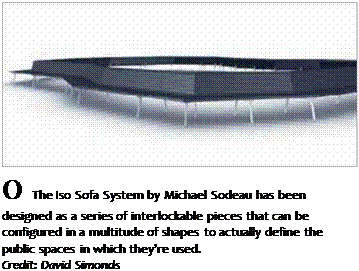
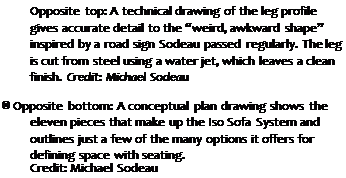 Asked by Modus to design a seating system for the contract market, Soudeau started working with a leg he’d originally envisioned for a chair. This strange silhouette was inspired by an equally odd source. “There’s a route I take quite often coming to work,” Soudeau explains. “And there’s this road sign in Camden that shows the direction the roads go when they split. It was something I registered subconsciously and then turned into something three dimensional.”
Asked by Modus to design a seating system for the contract market, Soudeau started working with a leg he’d originally envisioned for a chair. This strange silhouette was inspired by an equally odd source. “There’s a route I take quite often coming to work,” Soudeau explains. “And there’s this road sign in Camden that shows the direction the roads go when they split. It was something I registered subconsciously and then turned into something three dimensional.”
When he began reviewing the brief from Modus, Sodeau also found himself “. . . thinking on a grand scale, about seating hundreds of people.” He then stepped back a bit farther, and started to consider how he could go beyond the simple functional demands of seating, and actually change the environment itself. “Instead of rows and banks of seating, as is traditional, I thought you could break up space in an interesting way and still seat the same number of people,” Sodeau says. “It became more about changing the dynamics of an environment.”
The sofa he has come up with can be configured into a multitude of shapes with different combinations of eleven components of varying lengths and angles. Each piece is bolted together at a leg joint. “The idea of the system is to break up space. Where more traditionally you’d have bench seats and chairs, say, for example, in an airport lounge, this allows you to redefine the space of a room,” says Sodeau. “One advantage is that you can have the system actually snake back on itself. You can have social and antisocial seating, with pieces facing towards and away from each other.”
Sodeau found that manufacturing became an integral part of the design process. “Initially, the leg was one piece,” he says. “But there were some practical concerns with waste issues, so now we make it in two sections that allow us to have an extendable leg. The solution ended up being part compromise and part problem
і
solving.” Using 12 mm (7-")-thick aluminum, the legs were cut with a water jet. The process is similar to laser cutting, but leaves a cleaner edge, which minimizes the need for finishing. The legs then receive an etching that gives them the look of light sand blasting. A coating is applied to protect the finish. Soudeau points out that this process is “. . . much more modern and allows you more flexibility in production because you’re not required to do the massive production run all at once.” The finish also allows all the components to look natural when put together, unlike, for example, brushed aluminum, where the patterns would need to match.
“The components are quite strange,” he continues. “Usually, you’d have a heavy cast leg. But here, it’s quite mechanical, the structure and the frame, but there’s something quite light about it.”
|
152 DESIGN SECRETS: FURNITURE |
|
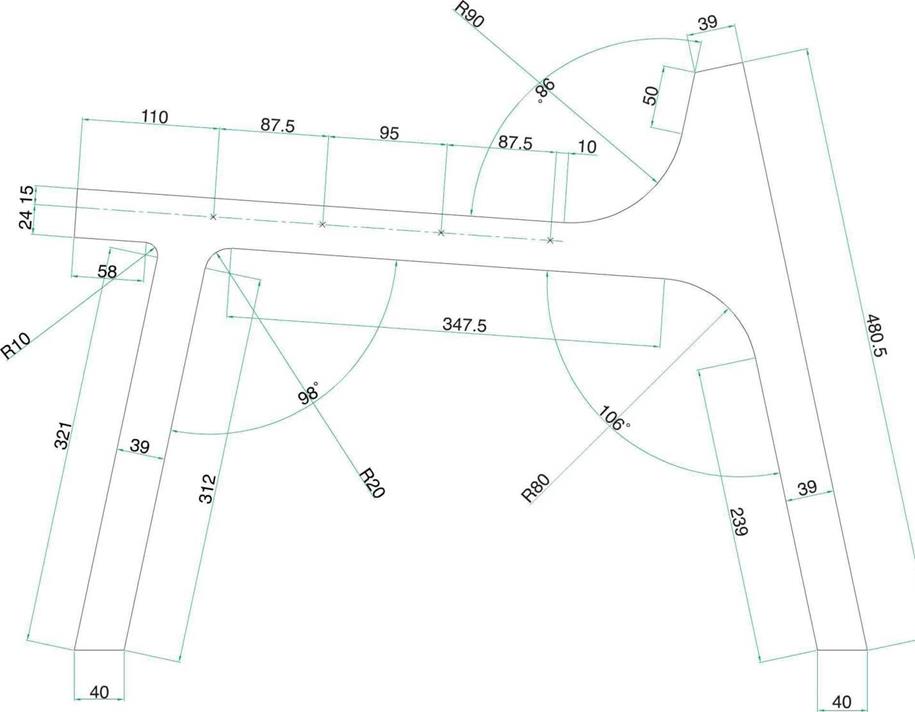
|
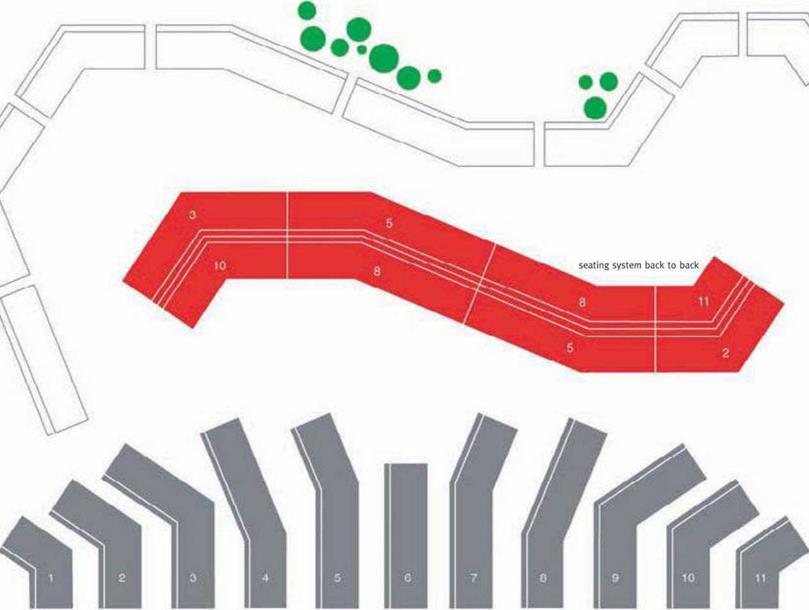
The Iso Sofa is built on a fiberglass subframe that provides structure and strength in a very thin profile. The seat and back are made of layers of multidensity foam and quilted fabric. Finding the right balance between creating a slender silhouette and the practical concerns of comfort was Sodeau’s biggest manufacturing challenge. “We’ve hit on an essentially satisfactory ground where the sofa is comfortable and the profile is as thin as possible, while retaining its comfort,” he explains. “We also put cross members on the legs, which aren’t visible underneath, to give it more support and structure.” Developing the right upholstery technique required some trial and error. Much like “Goldilocks” in the fairy tale, Sodeau found one option was too hard, another too soft. His solution: combine them all in a layered sandwich of foam, Dacron, and the final, exterior fabric.
The return at the top edge of the sofa is an example of form doing double duty for both function and design. Coming just below typical waist height, the return is practical and elegant. “Because the system is fiberglass and made with a kind of extrusion rather than a mold, the return adds strength to the piece,” says Sodeau. “And because it’s public seating, it also provides an extra place to perch, or sit, or set something down.”
Sodeau finds the entire process of moving a design from idea to reality part of the artistic challenge. “Most of the time, I have some subconscious ideas. But unless you sit down and rationalize your ideas, they won’t turn into very much,” he says. “The limitations of materials and manufacturing are inspirations. If anything, it would be more problematic if there were no constraints. Constraints are quite therapeutic. It’s all in how you approach them, whether you see constraints as a closed door or an opportunity to try something different.”
Sodeau also found some unexpected inspirations in designing for a commercial space. “The application is quite strange,” he says. “Normally, when you design a piece of furniture or an object, you have a single person in mind who is going to walk in and buy it, who will consume the product. This is a different scenario in that it is something inflicted on people, in that it’s public furniture. It’s nothing you would choose. Someone is making a decision for everyone.” Taking responsibility for the public space and public comfort became a part of his design process. “I wanted to pare it down to bare minimum and then add in what would be friendly elements,” Soudeau says. “For example, the fold on the back to provide a perch, the quilting that adds a little more comfort. It makes it more engaging for the people using that public space.”
The Iso System also embraces an unusual aspect of the unknown. While most furniture is bought as a complete and static object, this sofa becomes part of space planning itself. “It’s almost an experiment, if you like. There’s no easy way to try it out,” Sodeau muses. “This piece will become part of the building and how it’s used. It will direct foot traffic, for example.” To be complete, the Iso System requires the active involvement of an interior designer or architect who will determine the sofa’s ultimate shape. Sodeau is looking forward to some pleasant surprises. “There comes a point where you have to sort of cut the cord of a product and let other people use it, interpret it, engage it,” he says. “Only then can you gauge whether it’s a success or not.”
|
154 DESIGN SECRETS: FURNITURE |
|
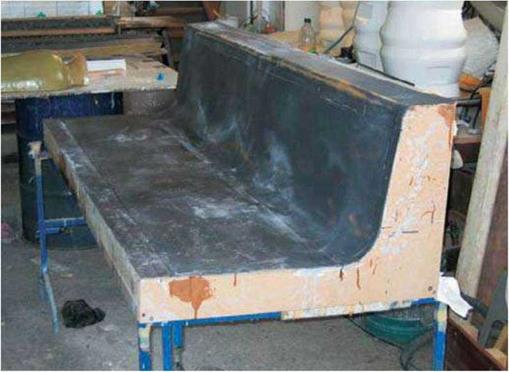 |
A mold for the extrusion process will make the very thin fiberglass shell that is at the core of the entire Iso Sofa System. Credit: Michael Sodeau
Above right: The fiberglass shell is covered with a thin layer cake of various forms of padding and quilted upholstery to create a seat that is comfortable in spite of its very thin profile. The back return adds strength to the piece, and offers people a perch to rest a bag or themselves. Credit: Michael Sodeau
® The steel frame is made so only the cantilevered shape of the leg will show in the final piece. The underlying crossbeams add support without being visible. Credit: Michael Sodeau
This computer rendering shows a few variations on the Iso Sofa configuration options, as well as the Sit Chairs that were the sofa’s precursor.
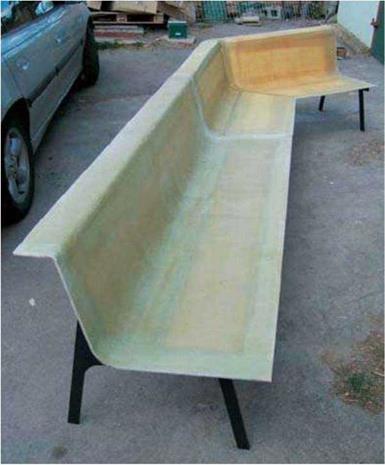
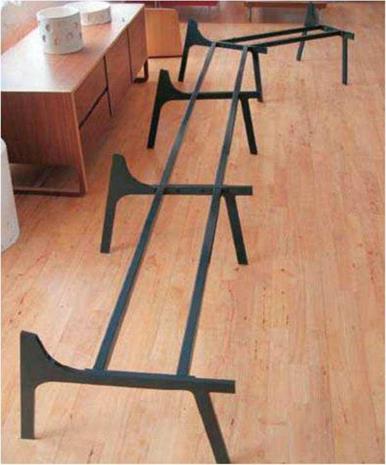 Credit: Michael Sodeau
Credit: Michael Sodeau

